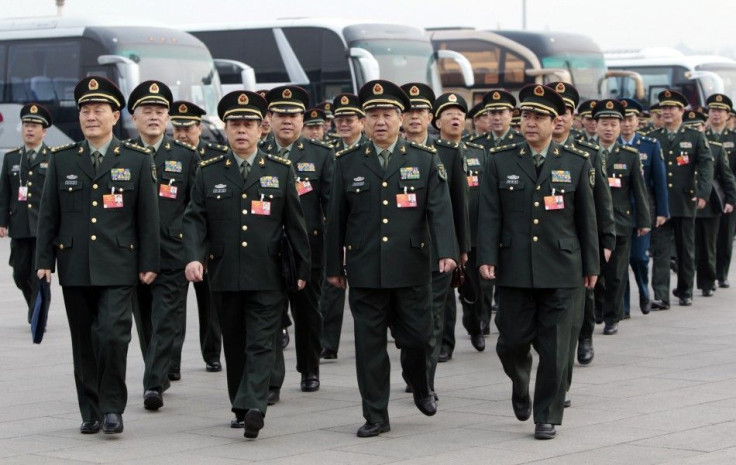China to Raise Military Budget by 11.2% for 2012

(Reuters) – China will boost its military spending by 11.2 per cent this year, the government said on Sunday, unveiling Beijing's first defence budget since President Barack Obama launched a pivot to reinforce U.S. influence across the Asia-Pacific.
The increase was announced by Li Zhaoxing, the spokesman for China's parliament, and will bring official spending on the People's Liberation Army to 670.3 billion yuan (67 billion pounds) for 2012, after a 12.7 per cent increase last year and a nearly unbroken string of double-digit rises across two decades.
Beijing's public budget is widely thought by foreign experts to undercount its real spending on military modernisation, which has unnerved Asian neighbours and drawn repeated calls from Washington for China to share more about its intentions.
Li said the world has nothing to fear, and the money spent on the PLA paled in comparison with the Pentagon's outlays.
You can see that we have 1.3 billion people with a large land areas and a long coastline, but our outlays on defence are quite low compared to other major countries, Li told a news conference before the annual session of the National People's Congress, the Communist Party-controlled legislature that will approve the budget.
China's limited military power is for the sake of preserving national sovereignty, security, and territorial integrity, said Li, a former foreign minister. Fundamentally, it constitutes no threat to other countries.
Asian neighbours, however, have been nervous about Beijing's expanding military, and this latest double-digit rise could reinforce worries in Japan, India and southeast Asian nations.
Obama has sought to reassure Asian allies that the United States will stay a key player in the area, and the Pentagon has said it will rebalance toward the Asia-Pacific region.
China shares its land border with 14 countries; it used to make sense that a country in such a position maintains strong conventional forces, said Kazuya Sakamoto, a professor at Osaka University in Japan who researches international security.
But in this nuclear age, it does not really make sense China, a nuclear-armed country, continues to build up its military at such a pace.
Obama's proposed budget for the fiscal year of 2013 calls for a Pentagon base budget of $525.4 billion, about $5.1 billion less than approved for 2012.
GROWING BOLDER
Beijing has sought to balance long-standing wariness about U.S. intentions with a desire for steady relations with Washington, especially as both governments focus on domestic politics this year, when Obama faces a re-election fight and China's ruling Communist Party undergoes a leadership handover.
But the U.S. pivot has also stirred disquiet in China, where some PLA officers called it an effort to fence in their country and frustrate Beijing's territorial claims.
China has advertised its long-term military ambitions with shows of new hardware, including its first test flight of a stealth fighter jet in early 2011, and its launch of a fledgling aircraft carrier in August -- both trials of technologies that remain years from deployment.
Beijing is also building new submarines, surface ships and anti-ship ballistic missiles as part of its naval modernisation.
China's military build-up is likely to continue unabated, irrespective of recent U.S. moves in Asia, the U.S. military commander for the Asia-Pacific region, Admiral Robert Willard, said on Tuesday.
Japan and China have locked horns over islands each claims in the East China Sea; Vietnam, the Philippines and other nations have challenged Beijing over claims to swathes of the South China Sea that could be rich in oil and gas.
SYMBOLIC VALUE, PRACTICAL LIMITATIONS
China's defence spending was 1.28 percent of its gross domestic product in 2011, while the United States and Britain both devoted more then 2 percent of their economies to their military forces, the spokesman Li said.
China's military modernisation need to be kept in perspective, said Michael Beckley, a research fellow at Harvard University's Belfer Center for Science and International Affairs, who has studied the national strength of China and the United States.
There's no doubt China's new hardware has important symbolic value and, at least in the case of the ASBM, important coercive value - the U.S. navy has to think twice now before getting too close to China's shores, Beckley said in emailed comments, referring to China's anti-ship ballistic missile.
But the PLA's progress needs to be viewed in the context of China's low level of economic development, he added.
China's economic weaknesses constrain its ability to produce cohesive military systems that link weapons and soldiers to sensors, satellites and command centres.
The Pentagon estimated China's real total military outlays in 2010 were over $160 billion, which would easily make it the world's second biggest defence spender after the United States.
In some areas, China is already able to put U.S. forces at risk, and that's all it needs, said Rory Medcalf of the Lowy Institute for International Policy in Sydney, who specialises in Asian security. If you look at a bigger picture than that at the aggregate force capability or the global stage, then of course the U.S. is a long way ahead, he added.
© Copyright Thomson Reuters 2024. All rights reserved.











